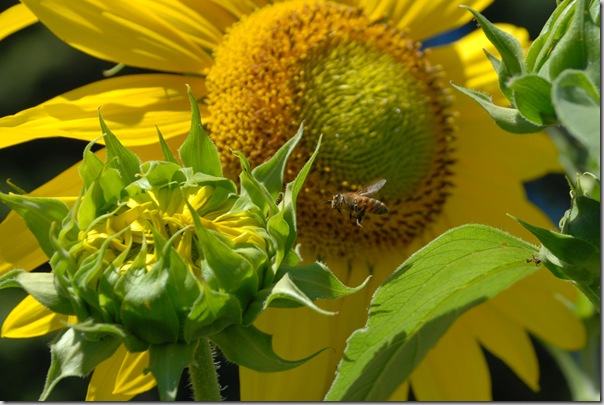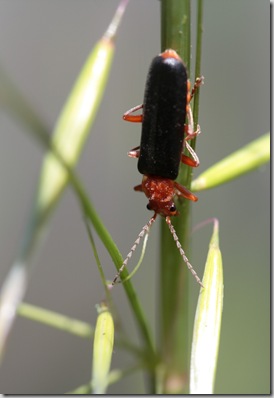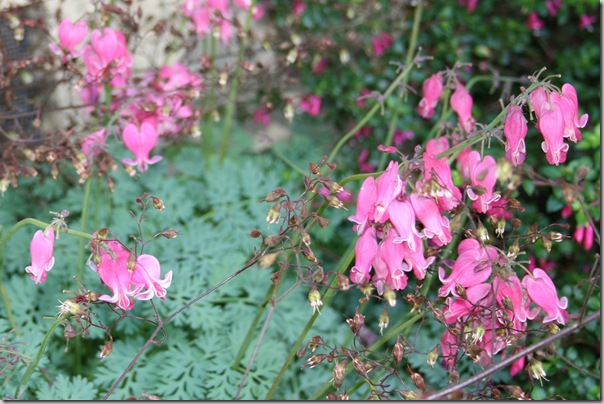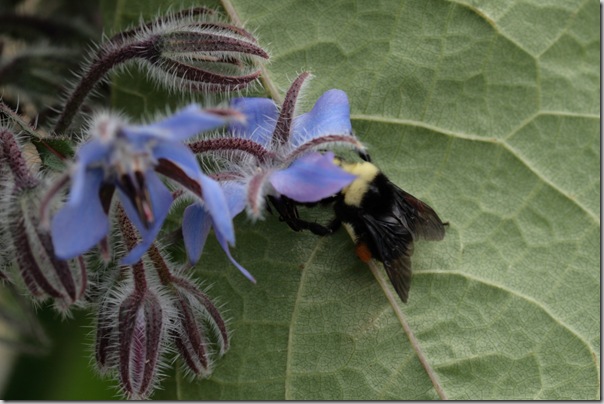Recently I was talking with a native plant aficionado, and she was telling me that the turning point for her in going native was when she looked around her gorgeous landscape, and realized it was barren of animal life. She had a garden simply brimming with flowers and beauty – but very little of the cheerful buzzing and chirruping that show someone besides humans are enjoying the space.
Now, I’m not a native plant purist. I love ornamentals and don’t think there’s anything wrong with planting for our own appreciation and sense of beauty. And there are other ways of supporting wildlife than gardening exclusively with native plants, as I’ll get to.

But she brought up an excellent point, which is that beauty in a garden lacks soul without bugs and wildlife, and if we want to attract them in, we need to be intentional in thinking about what makes a good habitat.
Even as a primarily ornamental gardener, there are a number of simple things you can do to invite more life into your garden.
Wine and dine ‘em:
Hey, it works on us ladies, right? This is one is the simplest ways to attract wildlife, but it isn’t always as intuitive as it seems.
Plant things that berry. Us landscape designers are often excited when breeders come up with a bigger-berried version of a plant we love, but this is one place we should use restraint. Most birds can’t eat berries bigger than 1/2 inch around, so getting that slightly prettier version may exclude birds from our fun.
The native plants in your area that birds have evolved to eat during certain times of year can be most helpful in attracting birds year-round, because birds are used to finding these plants at key times of the year to feast on them, and their berries are the right size, texture, and shape for chomping.
Providing water is one of the easiest ways to enjoy wildlife in your garden. A simple birdbath can attract birds to your garden year-round. Choose one with a roughened bottom so birdies don’t slip, and have it be no deeper than 3″ at the center. I like to place the birdbath in an open area where cats can’t stake out the bath, and set it near a tree so birds have an easy place to escape to if disturbed.
Put a few unpolished stones in your birdbath so bees can also drink. And if your birdbath freezes in the winter, check out these tips for providing year-round water to birds.
Plant nectar plants, like daisies, yarrow, lavender, sages, and mints. Not only can you attract hummingbirds and butterflies to your garden, but you can also attract the beneficial insects which eat aphids.
Encourage native insects. Most birds aren’t vegetarians, and their version of a steak is a nice juicy bug. If we encourage our native insects to flourish by planting native plants and only killing bugs that we are certain are being over-the-top mean to our plants, then birds will enjoy visiting our garden too.
Don’t be too tidy:
 I’ll be honest here – I love a clean-looking garden. I like to rake, shred and compost my leaves before spreading them in my garden, and I don’t care for dead flowerheads in the garden. But being selectively untidy can reap benefits for wildlife.
I’ll be honest here – I love a clean-looking garden. I like to rake, shred and compost my leaves before spreading them in my garden, and I don’t care for dead flowerheads in the garden. But being selectively untidy can reap benefits for wildlife.
Don’t cut down seeding plants till they’ve dropped all their seed. Many ornamental grasses, sedums and stonecrops, and other perennials provide seed for the birds to peck at in winter. Notice which plants birds are interested in, and hold off doing your winter-pruning until the birds seem to have eaten all the seeds and moved on.
Leave some bare soil for native bees. None of our California native bees are hive bees. Instead, the individual bees dig a tiny hole in bare soil, and lay a few eggs underground in a spoke-like pattern.
Our native bees aren’t nasty critters like wasps. Some of them only come out of the ground for a short time each year to drink from a few favored flowers, and the rest of the time, they hibernate peacefully in these tiny holes underground.
You can help them enormously by leaving a few areas of bare, non-mulched soil in the sunshine. Since it’s easiest to grow re-seeding annuals in bare soil anyway, I just hold off mulching those few areas so that native bees can have that as their habitat.
Let a few areas decay. Most of your garden can be neatly mulched, raked, and cared for, but if you can manage it, leave a few areas around the periphery for a rotten log or two and a pile of fallen leaves and twigs. In the shade, this area can stay more moist and provide a home for salamanders and frogs. In the sunshine, little snakes and lizards can enjoy having a place to hide. (Not sure about snakes in the garden? If it helps, they do eat garden snails!)
Learn your bugs, and kill the baddies using the most specific action you can:
I’ve written a lot about gardening organically, because I run a landscape maintenance company, and it’s my responsibility to keep people’s gardens healthy and free of pests. It can be tough, because insects are a vital part of our ecosystem – they feed birds and bats, and pollinate our food. Yet nobody wants to see a plant ravaged by out-of-control pests. The first step in finding a healthy balance?
When you see a bug, learn what it is before you bring out the flame-thrower. I have an excellent resource from Timber Press called Insects of the Pacific Northwest by Peter Haggard, and wherever you live, there’s sure to be a regional resource like that.
Sometimes we’ll find that a specific bug feeds a type of bird that’s local to you, and maybe it’s worth putting up with a small amount of damage to attract that bird. Or you could find out the bug sitting on your chewed-up plant is actually an innocent, and the culprits have sprouted wings and moved on.
Use the most targeted treatment available. If you find that you do actually have a garden pest on your plant, and there are more than just a couple, do a quick Google search to figure out what you can do to kill that pest without harming other beasties in your garden. Many biological controls only work on one kind of insect, for example, and won’t harm other bugs or birds.
Conversely, avoid using broad-spectrum sprays like most synthetics or the organic Pyrethrum. Those sprays kill everything in sight, and can also harm birds who eat affected bugs.
Prevent future pest problems by replacing sickly, overbred plants with sturdier counterparts, and use good maintenance habits to make the conditions in your garden inhospitable to pests.

Don’t know what to plant? Go for super-charged natives:
If you have a spot where you’re not sure what to plant, there are a number of high-powered native plants that provide food and shelter for a wide variety of local bugs and birds.
A few of the most effective wildlife-feeding native plants in Coastal Northern California? (Information from Peter Haggard’s article “10 Best Native Plants for Coastal Northern California Gardens”)
Red Alder and native Willows, which can provide homes to cavity-nesting wildlife like woodpeckers, owls, and sapsuckers, as well as food for a variety of insects and mammals.
Twinberry, which feeds long-tongued insects and hummingbirds with its flowers, then birds with its berries.
California Wax Myrtle, which provides winter food for birds at a time when other food is scarce.
Bugs need specific plants to lay eggs on. Douglas Tallamy, author of Bringing Nature Home, discusses the fact that many insects have chemical sensors on their feet which tell them whether or not they are on the right plant for laying eggs and reproducing. For many insects, the “right plant” is one specific plant. That’s it. If the bug can’t find that one plant to lay eggs on, it will die without reproducing, which can and will have a catastrophic effect on America’s ecosystem and farming if allowed to happen en masse.
That’s why it is so very important to plant some native plants in amongst the others. It truly is critical to ensuring not only their continued survival, but our own. Douglas Tallamy talks more about that on this free podcast from Timber Press, but the most important thing is being open to selecting some natives for your garden, and realizing that attracting native bugs is actually an important part of attracting wildlife to your garden.
Want to read more? Check out these posts from other garden designers around the US about creating a wildlife habitat in your garden:
Debbie Roberts : A Garden of Possibilities : Stamford, CT
Douglas Owens-Pike : Energyscapes : Minneapolis, MN
Pam Penick : Digging : Austin, TX
Rebecca Sweet : Gossip In the Garden : Los Altos, CA
Scott Hokunson : Blue Heron Landscapes : Granby, CT
Resources:
Peter Haggard’s book Insects of the Pacific Northwest
Douglas Tallamy’s book Bringing Nature Home

13 responses to “Attracting Wildlife: Simple Things You Can Do”
Many years ago I had an aphid infestation on my honeysuckle vine, so I decided to spray away with whatever chemical spray I had on hand. I was horrified to see the good solider beetles dropping like flies, as I realized I had inadvertently killed the GOOD along with the BAD. It was at that point I vowed never to use a spray like that again…..
Great post, Gen!
Thank you for Sharing your beautiful photos and advice. I will be recommending your blog as an example at an upcoming seminar.
Gen, I’m so glad to see you don’t advocate the flame thrower as a first line of defense for an infestation:) Seriously, your post is a thoughtful reminder that the choices we make in our gardens impact much more than their beauty. Your tip about knowing your insects is an important one…I bought a bug guide for my region this year and have referred to it a few times already just to make sure I’m not targeting one of the good guys. When you see your favorite shrub crawling with insects it can be hard to show restraint.
I am not an expert on insects and fauna, and also live in So Cal. So, this is coming from a perspective that doesn’t match your local conditions. I have started learning though, about our So Cal insects and small animals. And one of the things I am learning is that even the insect population is dependent on the growing of natives to keep their balance. Birds, the same way: if we plant a lot of exotics, the birds that were adapted to the natives get marginalized. It is a big, complicated issue.
Such an array of knowledge here that it is actually quite humbling!
But what really struck me was your inital point about how dead, perfect but dead, a garden can be without all this going on!
Thanks
Best
Robert
Genevieve, we are in total agreement about messiness – thank you! What, in nature, is pristine? I say focus on the beautiful, the interesting, the dynamic, and ignore the rest. Thanks for your good insights on pest control, too–a great read today!
I learned a number of things from your post today, Gen. I never thought about the size of berry a bird could eat; didn’t know about the native bees that live in holes in the ground; and didn’t know about insects with chemical sensors on their feet. Too cool! Great point too about mixing natives into an ornamental garden. It doesn’t have to be all or nothing.
I like your practical ideas for increasing habitat!
I like to position various water- capturng vessels around the garden since all forms of wildlife are attracted to them. Even an upturned broken and hidden pot holds the moisture that life requires.
“a garden lacks soul without bugs and wildlife” This is a truly beautiful sentiment! You’ve offered up so many tips and thoughts on the garden, that as Robert stated, it’s humbling. Very nice post and wonderful guidance on control of our pests!
My sentiments, exactly. When I started adding a few natives to my own gardens, I discovered the number of insects and birds increased. I began to wonder where they had been hiding, but they were not hiding at all. They had simply not found a good reason to visit until I laid out a picnic for them.
Thank you all for your lovely comments and contributions. I’M humbled by the depth of knowledge of all of YOU! Seeing everyone’s gorgeous photos of nature and hearing your own commitments to creating habitats and inviting nature to be a part of our gardens and landscapes is an inspiring thing for me.
Julia, I love how you put it – “They had simply not found a good reason to vsit until I laid out a picnic for them.” I love it.
[…] : A Garden of Possibilities : Stamford, CT Douglas Owens-Pike : Energyscapes : Minneapolis, MN Genevieve Schmidt : North Coast Gardening : Arcata, CA Pam Penick : Digging : Austin, TX Scott Hokunson : Blue Heron Landscapes : Granby, […]
[…] Gardening for Wildlife: a Compendium of Tips […]